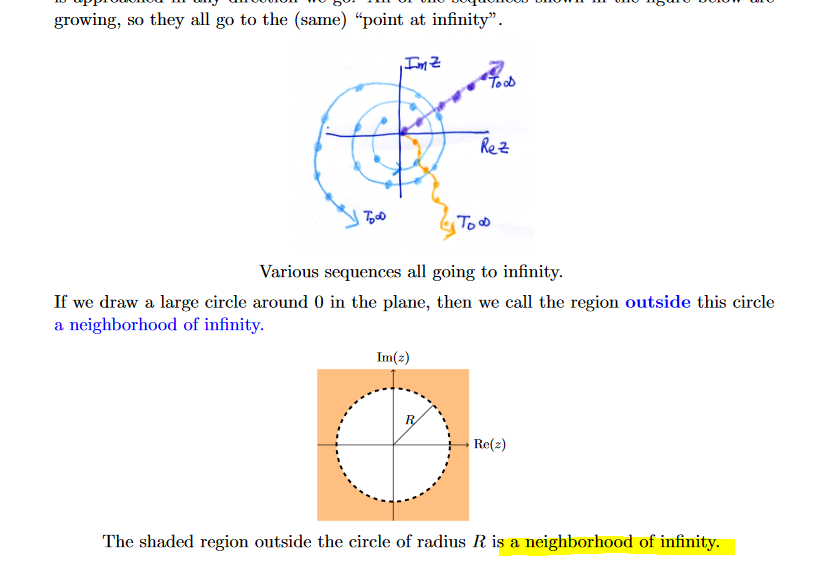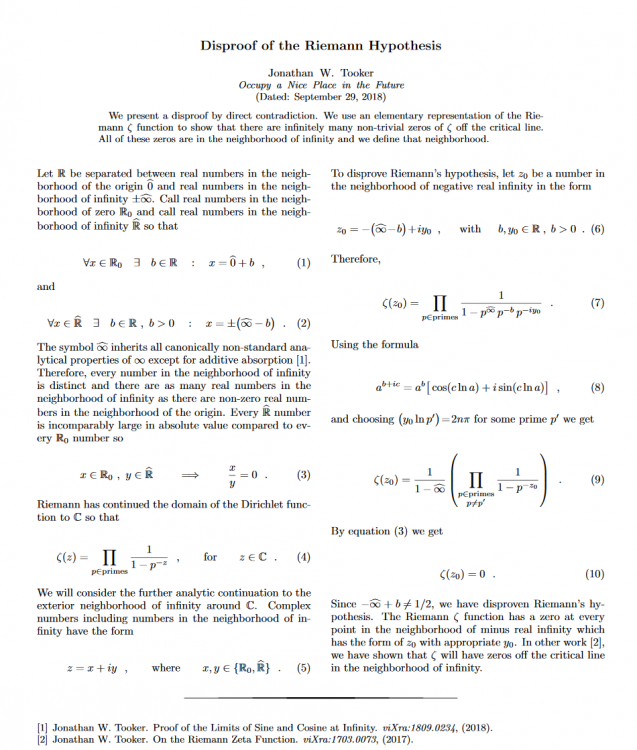-
Posts
22 -
Joined
-
Last visited
Profile Information
-
Favorite Area of Science
physics
Recent Profile Visitors
2408 profile views
sevensixtwo's Achievements

Quark (2/13)
-18
Reputation
-
Nah, you are wrong.
- 49 replies
-
-4
-
Pretty much, yup.
-
I agree that the rules you have proposed lead to the implication that infinity is a real number but I am not willing to concede that these rules are part of the definition of a real number. For that, you would need to present some third party source which say the rules you posed are part of the definition of real numbers rather than merely some properties which can be derived by only considering real numbers in the neighborhood of the origin. Until you do, I will stick with the definition in my real analysis book. If you have such a book it is probably in yours too: real numbers are cuts in the real number line. I just tried to google it and Wolfram doesn't define real numbers but I found the same definition on Wikipedia. I can post the link to Wikipedia if you want. Since you seem to have a brain and are not trolling me like user name "stupid idiot," what is your opinion on an implication that infinity is a real number?
- 49 replies
-
-3
-
(1) Yes I can. You can make your same argument about "cannot" regarding the square root of a negative number and yet we use those every day. (2) I use exactly the usual definition of a neighborhood of infinity. You are totally wrong. If there is some inconsistency with the definition of a real number number as a cut in the real number line then I challenge you to identify it. If there is some other inconsistency besides that, then those are only properties of real numbers in the neighborhood of the origin. (3) I am discussing a region of the complex plane which has been previously neglected but the neighborhood of infinity is absolutely in the complex plane. Again, you are totally wrong. Thank you. I agree that (infinity - b) + b = infinity , but I do not see how that implies that infinity is a real number. My definition of a real number is the one I learned in the first five minutes of the first lecture of my first semester of undergraduate real analysis: a real number is a cut in the real number line, only that and nothing more. All other definitions have to do with fields of numbers and other more complicated things that exceed the definition of a real number.
-
Zero is the same as zero hat. I use the hat to make a formal distinction between R and R_0 so that R_0 mirrors hat R in the notation. I don't see what you're getting at in your posted reasoning, nor do I feel like I understand what you have proven (attempted to prove) with it so I can neither agree nor disagree.
-
yes That doesn't follow. If you think it does, please give two real numbers whose difference is infinity. Before you do that, please consider that if you define a real number as numeral rather than as a cut in the real number line I will have to remind you that the definition of a real number is that it is a cut in the real number line. That would be the paper I posted in full in OP post of this thread. Here is link, if you would like to click it. I'm not sure what I could clarify for you without simply copying a sentence from the paper. Is everything clarified for you now? I'm not able to discern any request for clarification in your most recent post. Maybe you are asking if "b" can be a real number in the neighborhood of infinity. The answer is no; I have used "R" in the usual way to refer only to numbers in the neighborhood of the origin without "hat 0" inserted for clarity. I have not proposed to modify what we use the symbol "R" for, I have only proposed to modify the concept of real numbers. In the future people might consider "R" to be the union of "R_0" and "hat R" but until they all agree to change what "R" means I will use it in the regular way: "R" = "R_0" without the "hat 0" symbol.
-
If you would have read the paper, you would have seen that "b" is a real number. There is no real number greater than infinity. Please read the whole paper. There are only a few sentences and I put all of them in there because they are important. Also, I have proven that there are non trivial zeros outside of the critical strip in the neighborhood of infinity. If you believe there is a proof that there are no such zeros then please post it. That would be really great for me to study because such a result would have a large impact on my research.
- 49 replies
-
-1
-
I say there is the same number of them because each uniquely labelled R_0 number has a hat R number with that same label, and there are no other hat R numbers except for those which share a label with R_0 numbers. In the paper I call this label "b" If you would have read the paper, you would have seen in the first few lines that infinity is "+/- infinity" and if you were familiar with analysis at even the undergraduate level you would know that these are the endpoints of the extended real line. You might feel more at home in the less advanced forum because these symbols I use are already quite basic.
- 49 replies
-
-5
-
You are probably not in the intended audience for the paper then.
- 49 replies
-
-2
-
No. The meaning is that ascribed to it in the sentence which describes it in the body of the article and the author, who is definitely me, has also provided a citation for anyone who cannot parse "all canonically non-standard properties except additive absorption." However, anyone who cannot parse that statement is probably not able to parse the similar statements in the citation. On the other hand, if you wanted to make the argument that something which has not been previously invented cannot be invented then I would be open to reading your argument.
-
That's a good question. I was trying to find the answer in the OP image, and it looks like there's a sentence and a citation for that very question. You should have a look and tell me if it answers your question. I think the numerical value of the radius of the neighborhood of the origin might not exist due to equation (1). What is your opinion regarding the question you asked?
-
-
Is what you're calling my "initial assumption" this picture? Much like I can assure you of many things, I can assure you that this is a real screen shot of a post by a real admin on this forum.
-

My argument against the Riemann hypothesis
sevensixtwo replied to sevensixtwo's topic in Analysis and Calculus
Not unless you read the paper that explains it.- 12 replies
-
-2







